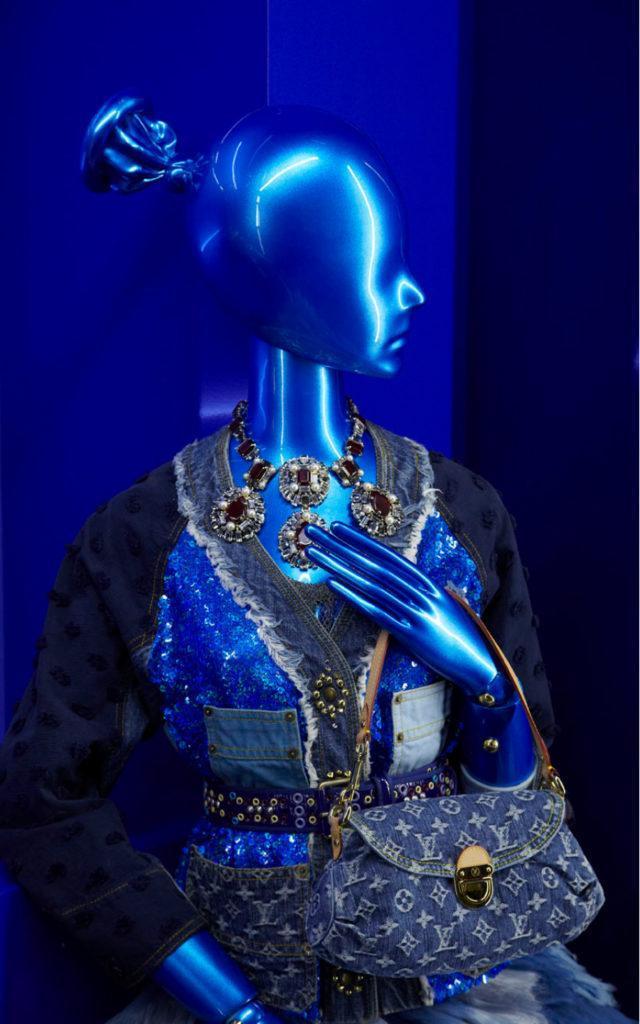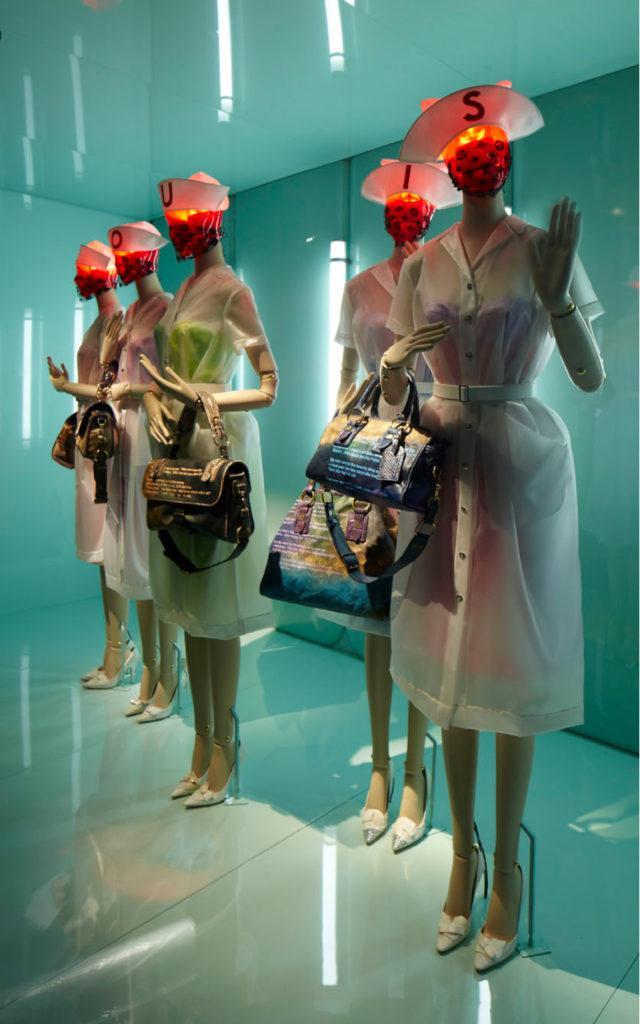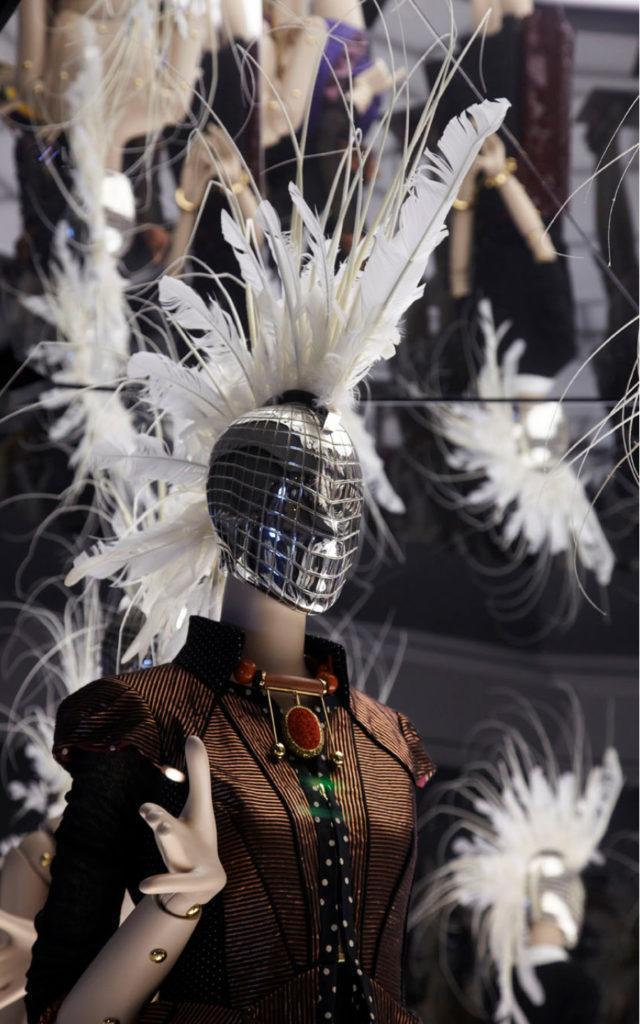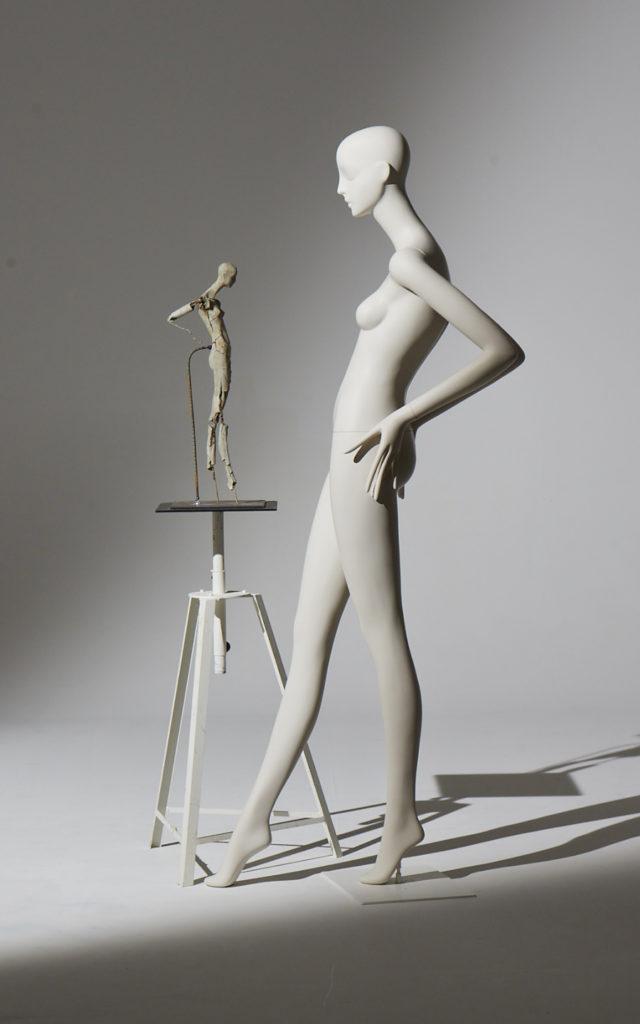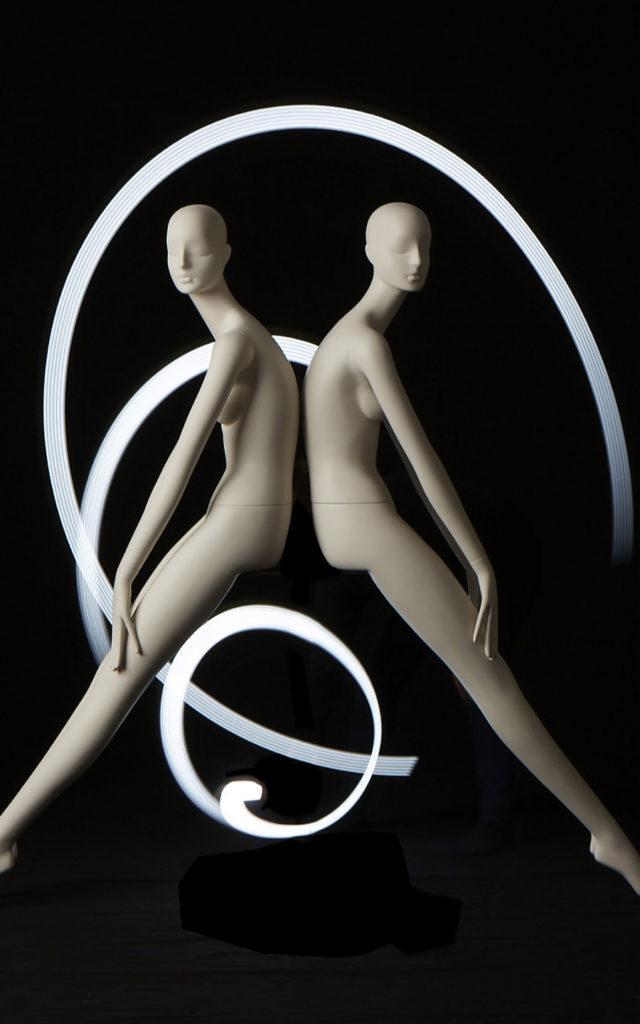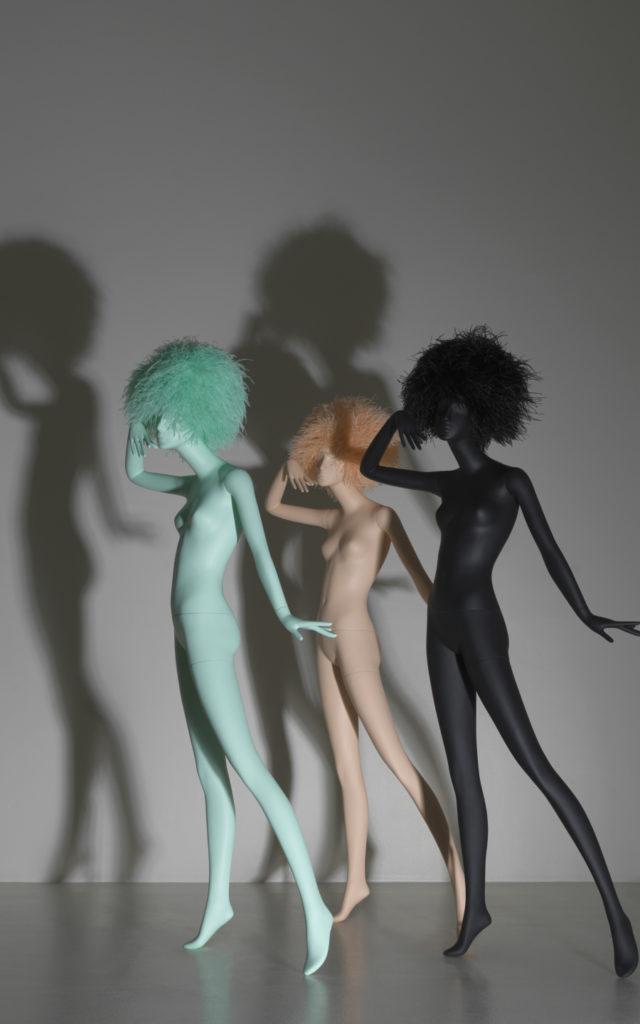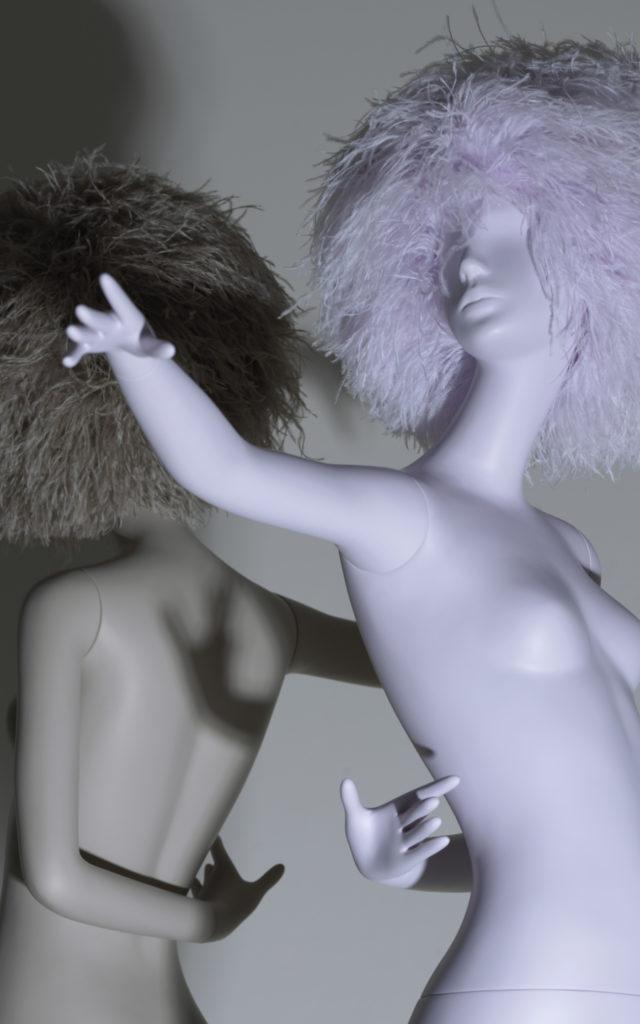This holds true for the collaboration and the personal harmony found in the relationship between Andrea Bonaveri and Emma Davidge; the former, CEO of Bonaveri, the latter, Creative Director of Chameleon Visual.
Brought up in the world of mannequins, and following in his family’s footsteps to become an entrepreneur in his turn, Andrea, at the helm of the company with his brother, Guido, has known how to ensure to the annals of history of the company whose name he bears, an increase not only in terms of size but also in an enrichment of the aesthetic and manufacturing quality of its bust forms and mannequins.
A Londoner, Emma began to work early on in the visual display sector applying her natural aesthetic sensibility to creating displays for shop windows while still at a young age. This natural talent matched with a strong determination which evolved through several years of freelancing experience leading Emma to create Chameleon Visual, a creative studio which over the years have developed collaborations with the leading figures in the fashion world.
For the past twenty years, Chameleon have been producing distinctive visual concepts for the finest brands within the luxury and fashion sectors. With an impressive client list, under the direction of Emma, Chameleon have made a name for themselves through their imaginative approach to visual display, from windows through to set design for runway, exhibitions, events and pop-up stores.
Based in South West London, Chameleon’s team adapt projects, pushing boundaries no matter how ambitious or demanding the project may be.
Thanks to these projects, Davidge’s and Bonaveri’s paths crossed. It was written in the stars that they should meet since both were committed to providing visions and products to the needs of the fashion industry.
What began as a simple professional acquaintance, with Bonaveri supplying mannequins for the brands that Davidge designed the store windows for, little by little, took on shape. With a constant characteristic: every time Emma worked on a particularly complex project conjuring up imaginary forms, structures, positions and innovative stage effects, there was nothing to do but turn to Bonaveri to check the workability of those forms and body compositions.
This is how in a playful sense of the word, making the impossible possible came to be. Those impossible visions that Emma designed to tell the public about a fashion brand’s DNA and projects, could only become reality in Bonaveri’s sculpture atelier, his sewing shop and in his workmanship.
All of this is only made possible by combining the visionary capabilities of an art director, pushing the boundaries of her imagination, and the entrepreneurial skills of Andrea, always thrilled by the challenge, always searching for ways to turn the ordinary into something extraordinary.

How did you meet each other?
Emma Davidge. We had done a few projects for Louis Vuitton where we needed some acrobat mannequins; we had two campaigns for windows, which were a Circus window and EPI Magic. That was the first time I came to the factory. At that time I was working as a consultant for LV windows. When I was given the project of the LV exhibition at the Louvre, I needed a bespoke mannequin… And I don’t remember why, but I chose articulated mannequins. I am trying to remember why I chose them… Ah, because I was looking for so many different poses and things for the mannequins to do and rather than just making 20 bespoke mannequins I chose an articulated one which could used in a lot of different poses. And it came for a small maquette doll. So, I came here and I showed Andrea the project – and [looking at Andrea] your reaction was a kind of cool. Do you remember?
Andrea Bonaveri. No!
Emma. You can’t remember when I came here?!
Andrea. I remember you came here but I don’t remember my reaction.
Emma. You were terrified, believe me. Especially when we talked about the time frame. Well, the thing was that the mannequin didn’t exist anywhere. It came from a small doll into a full-sized mannequin and we had to understand how to make it, how we could put it into poses, how we could keep it in the positions. How we could change the heads. We ended up with two versions: we had a fully articulated one and one with fake articulated legs, because it was impossible at that time to make the mannequin stand up, because it was so heavy.
She had a variety of different types of heads, made in London by my sculptor: some animals heads, there was a smoke head, a balloon head, a disco ball there were a lot of different crazy heads that were made for them. And then it was the collaboration of bringing everybody together and Marco the sculptor (Marco Furlani, Bonaveri’s sculptor, see the article about the atelier, editor’s note) came to Paris and he had to help us install them, because it was brand-new and we didn’t even know how to put them together!
And which year was it?
Andrea. 2012.
Emma. So glad you remember [She laughs].
This was the most challenging project together?
Andrea. Also the windows were quite difficult to realise, because every single mannequin was so special.
And then you invited Emma to collaborate for other projects?
Andrea. I mean, I think at that time a friendship was started and we began collaborate on other projects.
Emma. Then we made the Speedy mannequins, with the magnetic bag heads. We did those when LV opened the store on Bond Street in London they were for the Katie Grand exhibition that was travelling the world.
Andrea. And then for Bally we did mannequins on different types of bicycles.
Emma I forgot about those! They were bespoke mannequins riding bicycles, it was for the presentation of the collection. And then it blurred into a huge amount of projects. We made bespoke up and down legs for Fendi, and many others, but basically everything is bespoke. Andrea is the best in the world to work with, because he can pretty much do anything.
Andrea. Don’t exaggerate! She is really the best in the world.
Why Andrea do you think so?
Andrea. I don’t know. Actually I do know. When she designs a new project, it’s really unique. Not only for us, but also for other fashion designers.
What do you mean by unique?
Andrea. Unique for me means everything. Every time she brings me a project I am wondering how she does it, how she can conceive something like that.
So how do you do it?
Emma. I don’t know! I’ll tell you how I work. I am a visual storyteller and my job is to delivery a story that brings some kind of an emotion whether it be to a child or an adult. No matter what language they speak and wherever they are in the world, I would like to think they can look at the story I am telling and understand it.
So it’s like being a silent actor on stage. That’s how I view it.
And also the mannequin is a silent actor on stage.
Emma. Yes, it is the main actor. Mannequins are telling the whole story. So that anybody in any language, in any culture, in any age, can look at something and tell their own fantasies, because, when I was a child, that’s how I got into window dressing.
On the weekend I used to stand outside shops with my dad, with my face pressed into the glass, when my mum would go in the shop, and I would be making up stories about where the mannequin was going, what she wanted to wear and I would create my own fantasies. So that’s how I still work now.
Then you did some visual school?
Emma. No, I didn’t. I left school at 16 and I got a job with Joan Burstein at Browns store and she trained me for three years, and then the rest is history. So I have always been in luxury.
Browns has always been ahead of its times.
Emma. Joan Burstein developed the first multi-brand store, like before anybody. I had the luxury of working with her. I am kind of really grateful she was the one that trained me.
And after Browns? You were very young, not yet 20?
Emma. I was 16. After Browns I went to Selfridges and I learnt about department store display, for maybe three years, and then I moved to Italy, where I had a lot of multi-brand customers like Romeo Gigli, Genny, Moschino… I used to dress their windows freelancing, travelling Europe the rest of the time.
Then I went back to London… and what did I do? [She thinks] Ah, I went to work for Jigsaw, where I became assistant to the creative director and, then, one day I just left and started my own company. I created Chameleon Visual in 2004.
And you started to collaborate with the big companies such as LV, Fendi… and then Bonaveri came into play.
Emma. Bonaveri has always been in the game, because I have always used either Rootstein or Bonaveri mannequins throughout my entire career. There is a specific taste level when you are choosing or dressing mannequins, and it was either Rootstein or Schläppi. That just how it is.
And now you are designing some Schläppi and also you are collaborating on the new Twiggy. How did she come about?
Emma. Andrea and I had a conversion four or five years ago, whilst we were driving back to Ferrara late at night from the Milano showroom. I said to Andrea: “Maybe you should buy Rootstein!” It’s about a two- or three-hours car journey, and we talked a lot about Rootstein but the conversation then finished. Later on, a few years later, one day Andrea said: “Oh I have some news!” And yeah, he was in the process of buying Rootstein, which was very exciting. With Twiggy, I have curated the styling and Andrea has done the main bulk of the collection.
For Bonaveri you designed Aloof, Tribe collection, and Obsession that is launching these days. What about this last one?
Emma. Schläppi has a certain DNA and I love one of the first creations which I nicknamed “the Monkey” because her pose reminds me of a monkey. There is just this beauty and elegance in her elongated fingers, limbs and neck… she’s stunning. And when you also go through the archive pieces, which you don’t see in the factory, the moulds, the faces and lips are generally very awkward, which I find very attractive.
When I looked at the original Schläppi mannequins, I really wanted to translate them into modern days and create mannequins with the right height, the right size but still with that awkward beauty to them…something that people want to buy and that will be timeless.
So, when we created Aloof, I was inspired by the ‘40s and ‘50s and then with Obsession we moved into the ‘70s and it was very much Pat Cleveland, Jerry Hall, Grace Jones and Diana Ross. Pat Cleveland for example was one of the first supermodels, the face of all the brands in New York from Halston all the way through. I looked at that Studio 54 era, when they were all used to hang out together and when you see them dancing – and you see them whirling and twirling on the dance floor – that’s where all the movement and the ‘70s attitude comes from. So here is the inspiration but making it timeless and making it very Schläppi. So when you mix awkward with movement you get something really beautiful.
Timeless you said, in an industry that is the opposite by definition.
Emma. You know the mannequin is the actor, she is going to be changed every five minutes, a dressing rotation in a fashion store is very two weeks. But the mannequin needs to be timeless in the sense that… I want someone to go into the archives in a hundred years’ time and pull our pieces out and be as excited by them as I am now looking at the first Schläppi; I would like to think that somebody in the timeline will continue Schläppi heritage. Going back to the pieces Andrea and I have created… I would like people can say: “Wow, amazing!” 2020: how old she is now?
Andrea. Schläppi is from the beginning of 1970.
Emma. So she is 40. You look at her now and she is still in windows, she is still there.
Andrea. This is the iconic mannequin, this is “The Mannequin”, no other mannequin is so famous and so successful and unique. Schläppi 2200: is the only one in the world.
Going back to the new Obsession collection, I would like to add a note regarding their pose: all the mannequins in the windows now are standing straight like soldiers, with straight legs and straight arms, but you [looking at Emma] now have designed a completely different mannequin. And I like the idea to change in an opposite way.
Here in fact is Obsession, dancing on the dance floor. Both of you are taking a new risk.
Andrea. It’s about risk all the time. When we started to design Aloof, the market was completely different, nobody had made a mannequin like this before.
Emma. With Aloof I had an obsession with twins. As a window dresser, the one thing since the beginning of my career that has frustrated me was that, when I wanted symmetry – because I love symmetry – I couldn’t find it anywhere: if I wanted two mannequins back to back, one would be looking at the wall of the window and one would be looking at the glass… impossible. So with Aloof I made them twins, they are symmetrical, so they sit together, they stand together, they can go in a big army together and also you can come back to the possibility of bespoke: take the head off and make one turning and so on. And that was a huge appeal to everybody who bought Aloof, because finally things were possible.
This is where the collaboration is amazing: Andrea knows mannequins better that anybody and he taught me everything I know about production, and I know windows and I know the insights. So when you bring these two worlds together, it becomes very powerful.
When we launched Aloof, she sold instantly, it was amazing! I first Andrea said to me: “So don’t worry if it doesn’t sell for the first three years, it takes time,” but we were selling them even before we had even finished sculpting the collection. And then Max Mara launched them globally and then it went boom…!
You both together have impeccable intuition.
Emma. I don’t have strategies for anything. I normally just go goose bumpy and … “This is it,” I just know.
I think I have approached the industry very differently. People get caught up in the fashion, in the name and the glamour, but I am not really interested in that. I am interested in telling stories.
I live in this body every day, for me what I do is just normal, it comes naturally, I don’t really care about what other people say. I like to be behind the scenes, and that’s why my company is called Chameleon, we blend into the background. The story I am telling is about the client, it’s not about me. Everyone has a story to tell and I like to dig around because there is always some magic that happens when you show it to people.
So it’s the same when we worked for Pucci (see Laudomia Pucci interview, editor’s note).
I wanted the very strong DNA of the house of Bonaveri and of the House of Pucci to combine together. There is a story in everyone’s archives. I know the DNA of Bonaveri because I work so closely with Andrea, and on the other hand I had to go and find out the DNA of Pucci. Laudomia told me that her father was a pilot and saw everything from a bird’s eye view, which is how the first scarves were made and I took things like that, sifted through information and connected them in unexpected ways.
Why Emma did you want the title of this interview “Making the impossible possible?”
Emma. Because most of the time when I have an idea, my first reaction is “Oops, this is going to be difficult”, but then I come here and Andrea just stares at me and says ”OK, let’s do it!” I like his bravery.
So you are the perfect partners in crime?
Emma: Yeah.
Andrea. Yeah.
Emma. He’s very chilled whereas I’m not so much. We push one another, we are also very similar in many ways and we are very passionate about what we do. It’s also about the taste level, we have a very similar one. So all of those things work. I have a lot of respect for him, in what he does.
I surround myself with people I like, there must be something in a person that makes me curious and there is a level you can understand, it’s like two children playing and that is when the magic happens and the adults disappear.
I care about Bonaveri as much as I care about my own company. It’s not just coming in, taking the money and doing a job, I really care as much as Andrea does, probably more sometimes! I can drive him mad.
Andrea. There is a good combination between us because I have the experience and you the vision…. Anytime we do a project, I tell myself “This is the last one.” But then I realise that it was just the beginning for something else to come.
